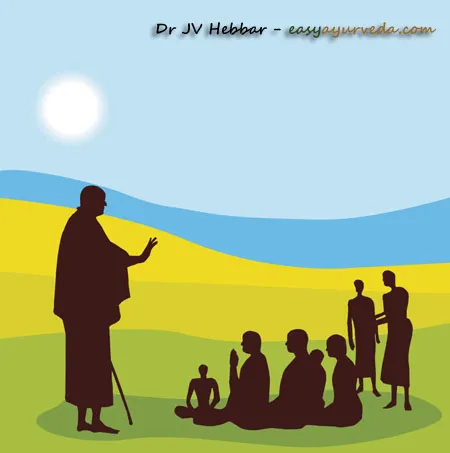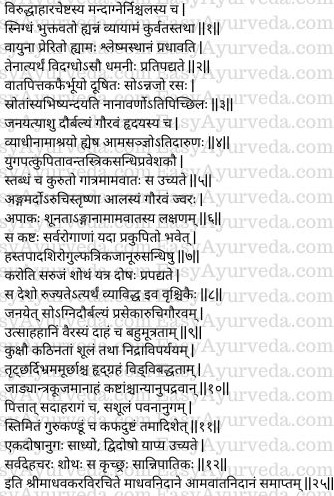Madhava Nidana Chapter 25 Amavata Nidanam

This article explains Madava nidana 25th chapter “Amavata Nidanam”. Causes, pathology and symptoms of Amavata are explained in this chapter.
Read – Acharya Madhavakara: His Work ‘Madhava Nidana’, Legacy, Amazing Facts
Table of Contents
Amavata Nidana
Etiological factors
- indulgence in incompatible (mutually opposite, incompatible and antagonistic) foods and habits,
- having low digestion fire (capacity),
- lack of physical activity, or
- doing exercise (indulgence in physical activities) immediately after taking unctuous (fatty) foods
Read – Amavata: Causes, Pathology, Treatment, Panchakarma, Medicines
Samprapti
Pathogenesis
- The above said etiological factors produce plenty of ama (improperly digested food, intermediate products of digestion produced due to the action of weak digestive fire in the stomach on the food consequently leading to sluggish and incomplete digestion). The vata too is aggravated.
- This ama being stimulated and pushed by aggravated vata moves towards different seats of kapha and gets lodged therein.
- Being excessively contaminated (further) and pushed further by the aggravated vata, this ama reaches the dhamanis (blood vessels).
- This ama is further contaminated by all the three doshas i.e., vata, pitta and kapha located in the dhamanis.
- Due to the contamination by all the three doshas, ama acquires different colours and becomes excessively sticky (slimy), produces excessive fluidity in all the channels of the body and causes obstruction therein.
- All these events produce quick weakness (debility) and heaviness in the region of the heart.
- This ama becomes the root source and causative factors of many diseases and hence is considered dreadful and dangerous.
- These vata and ama aggravated simultaneously would enter and lodge in the trika sandhi – pelvis and other joints of the body.
- This dreadful disease which produces stiffness of the entire body in due course of time is called as amavata. (1-5)
(Note – Trika Sandhi shall be considered as the joints in the pelvis or the meeting of three bones in the region of shoulder blade / shoulder girdle. This also includes sacro-iliac and sacro-coccygeal joints including lower lumbar vertebrae. Some have considered the words trika and sandhi separately. In this condition trika sandhi should be understood as the pelvis and other joints of the body.)
Read – Ama – Word Derivation, Meaning, Definition, Formation
Amavata Lakshanas
General symptoms of amavata
The general symptoms of amavata include – pain all over the body (in all parts of the body and joints), tastelessness, thirst, laziness (loss of enthusiasm), heaviness of the body, fever, indigestion and swelling of the body parts (and joints). (6)
Pravruddha Amavata Lakshanas
Symptoms of advanced stage of amavata
The severely aggravated and advanced stage of amavata (when it has become chronic due to long standing symptoms) is considered to be the most difficult one to treat in comparison to many other diseases i.e., it becomes incurable.
In this condition there is painful swelling of the joints of hands, feet, head, ankle, pelvis / waist, knee and thigh (hip), wherever the doshas tend to reach and get lodged. Apart from this, the person would experience severe pain resembling the pain of a scorpion sting in any place or joints of the body where the doshas reach (doshas here mean vata along with ama and other doshas as explained in the pathogenesis of amavata).
The other symptoms of amavata include – weakness of digestive fire (poor digestion), excessive salivation, anorexia, heaviness of the body, lack of enthusiasm and drive, manifestation of bad / odd tastes in the mouth, burning sensation, profuse (excessive) urination – polyuria, hardness of the abdomen, pain in the abdomen (colic), and erratic sleep patterns (excessive sleepiness in the morning and loss of sleep at night).
Along with these there is also excessive thirst, vomiting, giddiness, loss of consciousness, stiffness in the region of the heart, constipation, inability to do any work (loss of movements of the body parts – severe stiffness), gurgling sounds in the abdomen, flatulence (distension) and many other difficult complications. (7-10)
Read – Qualities And Symptoms Of Ama – Ama Guna Lakshana
Symptoms of associated doshas in amavata
- In amavata associated with pitta there will be burning sensation and redness of the affected joint (part).
- If vata is predominant in amavata the patient would experience severe pain.
- In case of kapha predominance in amavata there will be feeling as if his joints (and other parts of the body) are covered by a wet leather or cloth, heaviness and itching. (11)
Read – Association Of Ama With Doshas, Tissues And Waste Products
Sanskrit Verses

Prognosis
Symptoms of incurability of amavata
- Amavata caused by predominant involvement of any one dosha is curable.
- If amavata is caused by two doshas it will be manageable (persists for the rest of the life but needs regular and prompt treatment).
- Amavata, wherein all the three doshas are involved and presents with swelling which has spread all over the body (including all the joints) is said to be incurable. (12)
Thus ends the chapter on Amavāta Nidanam in Madhava Nidana text written by Acharya Madhavakara.










